Purpose of Personal Project Portfolio
This portfolio is to document my contributions made towards the project done in CS2103T. It highlights several of my code contributions as well as documentation additions to show the main feature I have been working on as part of the project.
About the project: Tagline
Tasked with enhancing the capabilities of a basic command line interface desktop addressbook application, my team of five chose to extend the functionality to include note-taking capabilities. Combining the existing contact infrastructure with tags and note support, we aim to make a more people-centric note taking platform we call Tagline. This application aims to help students more easily organize and find their notes based on the people the notes are connected to.
This is what our project looks like
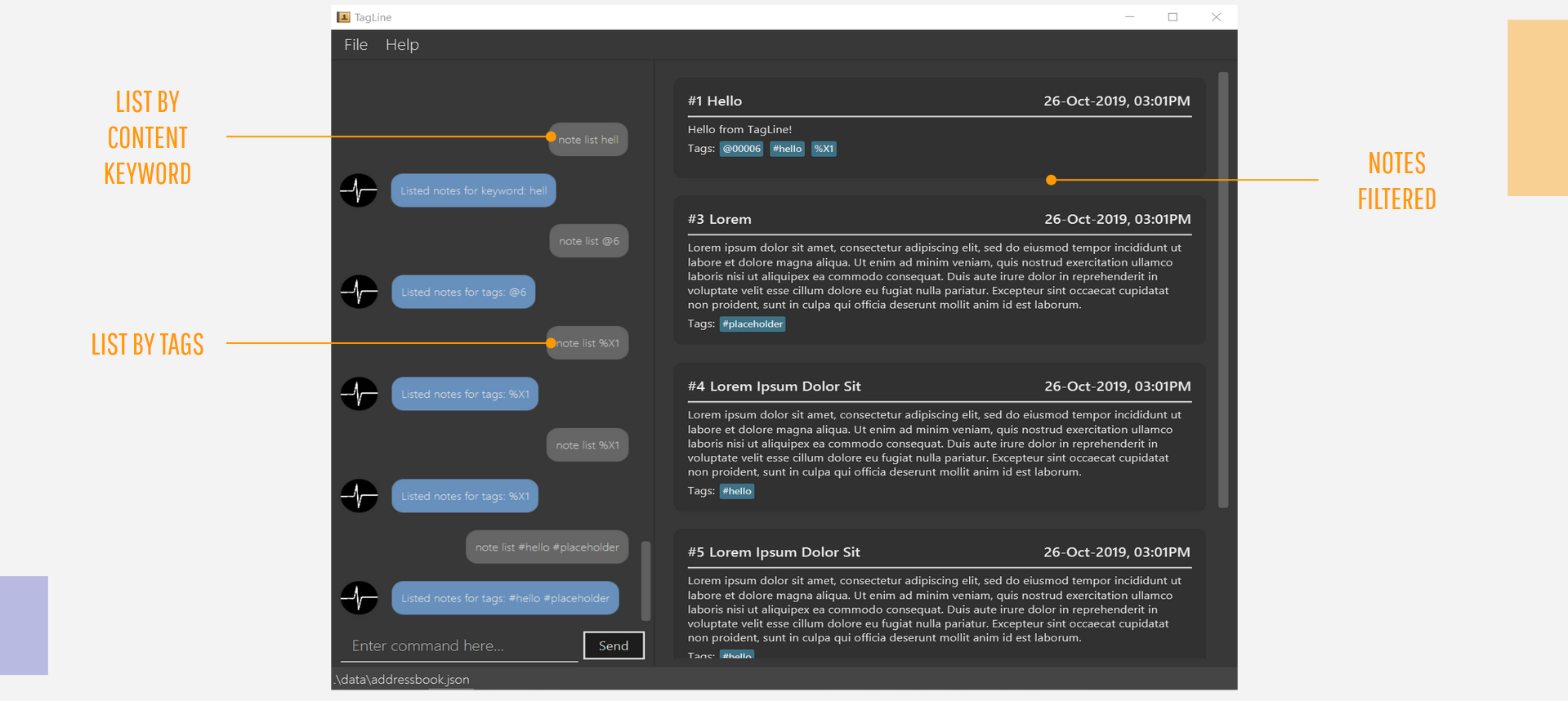
My role for this project is to implement the Group feature to allow for organizing Contact`s together into `Groups which can be used to manage notes as a whole. The following sections together with documentation added to the user and developer guides depict this enhancement in greater detail.
The following are the conventions used in this document:
-
GroupCommand- Texts with grey highlights indicates a class, object or a command that is used in Tagline. -
Functional code - Texts in blue are linked to reference webpages with further examples
Summary of contributions
In this project, I my main feature was to develop a way to organize contact together into Groups. This allows users to organize contacts in a more natural way based on social circles of relationships rather than as an alphatically ordered list. It would also lay the groundwork for other features such as group tagging of notes.
-
Major enhancement: I added a range of features providing the ability to group contacts together for better organization
-
What it does: with
group createa group of contacts can be created, contacts can be added or removed usinggroup addandgroup removecommands. Groups can be searched for and displayed usinggroup listandgroup find. -
Justification: social circles exist in more than just a one to one relationship and can belong in a group with a shared feature be it an orientation group of friends who all know each other or a project group with common purpose. Having the capability to quickly reference other contacts in the same group would make the user experience much better compared to scrolling through an alphabetically ordered list in an addressbook.
-
Highlights: this enhancements supplements the existing structure of the addressbook.
-
-
Code contributed: The following links highlight samples of my code [Functional code] [Test code]
-
Other contributions:
-
Documentation:
-
Updated the developer guide to better reflect
ModelandStoragecomponents after they have been changed to accommodate other features: NoteModel, StorageComponent
-
-
Community:
-
Contributed to forum discussions to clarify potential tripups (examples: 131
-
Reviewed and offered suggestions for other teams in class (examples: SecureIT#22
-
-
Contributions to the User Guide
The following sample highlights some of my additions to Tagline User Guide.
This is primarily for group features I had developed.
The following excerpt for |
Sample: group add command
Add member to a group: add
Adds members to a group.
Format:
group add GROUP_NAME [--i CONTACT_ID]+
Example:
-
Over time our 'ao3' group has grown with new members joining. We need to update our group to record the recent addition. To add a member to our 'ao3' group we can use the command
group create ao3 --i 90040
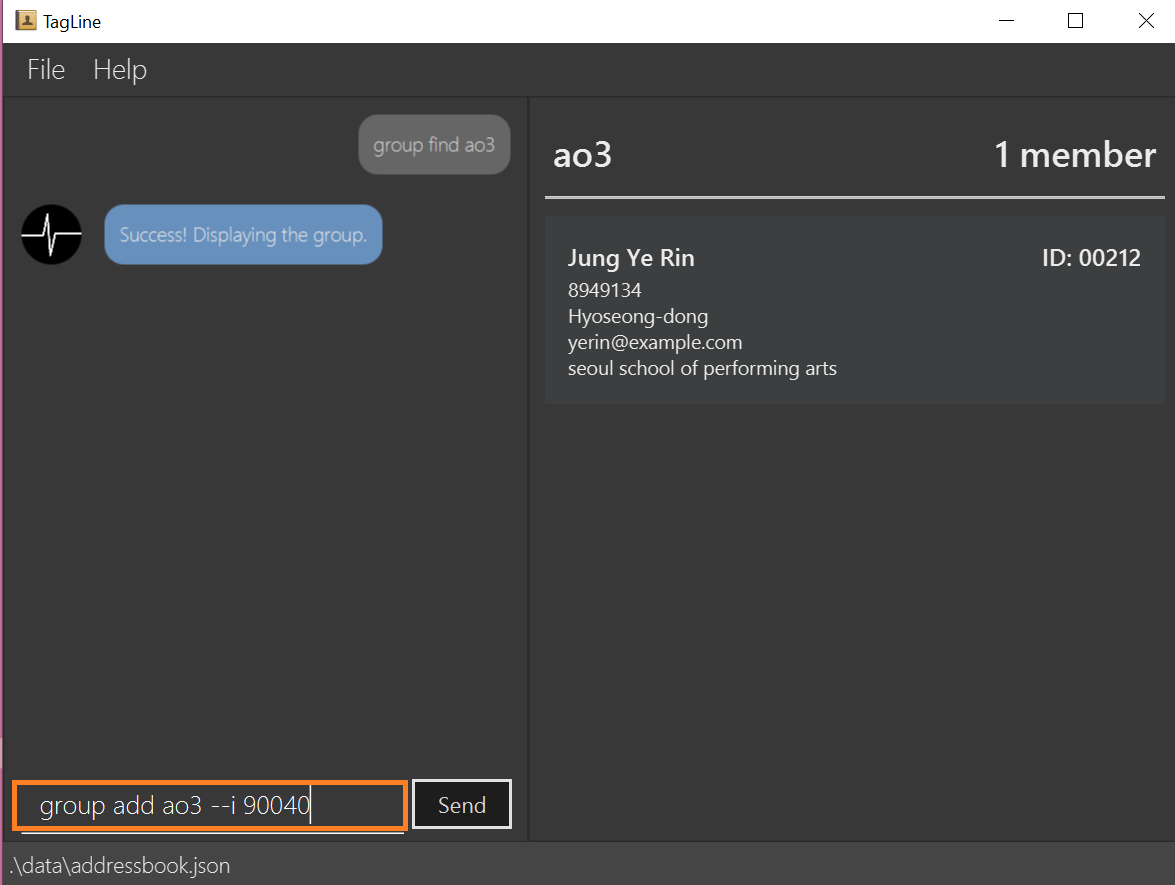
-
This adds a contact with ID '90040' to the group with name 'ao3' The display will show the group and the contact that has been added.
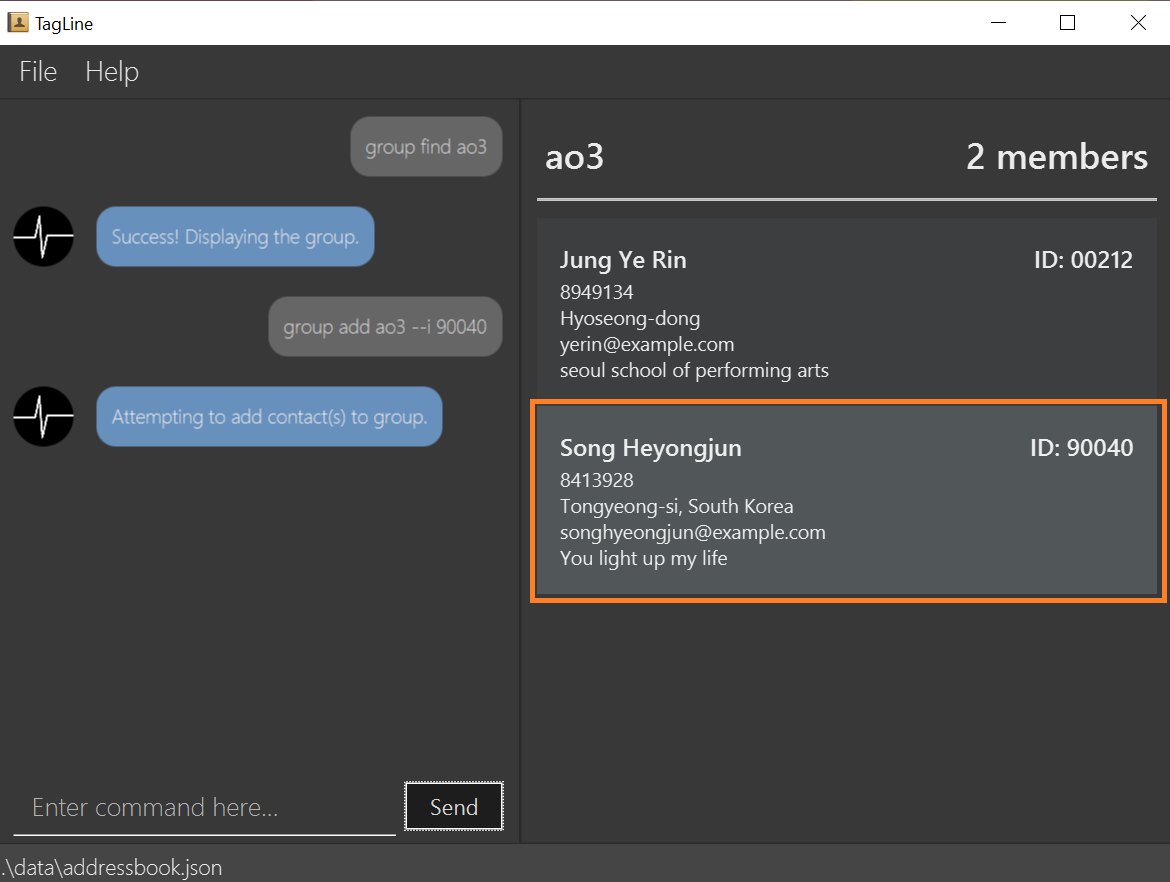
Contributions to the Developer Guide
The following sample highlights some of my additions to Tagline Developer Guide.
This is primarily for group features I had developed.
The following excerpt demonstrate my approach to writing documentation to showcase how I write technical documentation to explain how my developed feature functions to aid future developers better understand how the feature functions and the design choices considered and made. |
Group Contacts feature
Description
Groups allows users to better organize contacts into relevant social circles (represented as Group)
to better express relationships much like how they exists as in real life. This feature
would provide the foundation for further more advanced features such as tagging of notes with
group tags.
The user can work with groups by using the commands as detailed in the group section.
Commands currently available:
-
group create- creates a new group -
group remove- removes a contact from a group -
group add- adds an existing contact to the group -
group list- list all available groups -
group find- searches for group by exact name and displays contacts in the group -
group delete- disbands a group (contacts in group are not deleted)
Implementation
The grouping feature is facilitated by GroupBook, an additional Model component in addition to the current AddressBook.
It extends the functionality of AddressBook by providing a way to group contacts together into unique Group classes
identified by their GroupName. This allows users to form more natural associations of
contacts such as "BTS-members". Identifying which contacts are group members of a Group is done by
storing a record of their ContactId in the Group.
Additionally, GroupManager extends Tagline with the following operations to support
commands dealing with groups:
-
GroupManager#getGroupBook()— Retrieves a view only version of the groups for storing data after app quits. -
GroupManager#deleteGroup()— Deletes a group from the list of groups currently available. -
GroupManager#addGroup()— Adds a group to the list of groups currently available. -
GroupManager#setGroup()— Replaces a group in the list of groups with another group. -
GroupManager#getFilteredGroupList()— Returns a view only list of groups containing a subset of available Groups. -
GroupManager#updateFilteredGroupList()— Specifies which groups will be retrieved byGroupManager#getFilteredGroupList().
The above operations are exposed in the Model interface by their respective method names.
-
GroupCommand#findOneGroup()— Retrieves one Group with name matching the exact provided String. -
GroupCommand#verifyMemberIdWithModel()— Compares members currently in a group with contacts inAddressBookand returns only those found inAddressBook. -
GroupCommand#setDifference()— Used to get contactids specified which do not exist inAddressBook.
These above are static utility functions which form the underlying structure of how a GroupCommand works.
Given below is an example usage scenario on how a typical lifecycle of a Group behaves at each step.
With emphasis on showing the effects of DeleteCommand as an example of a command from ContactCommand
would interact with GroupCommand and GroupModel state.
Step 1. The user initially has several contacts in AddressBook.

The AddressBook model state contains all the Contact class that exists in the App.
Since no Group has been created yet, GroupBook model state is currently empty.
All of the contacts found in AddressBook are displayed on the UI by default.
Step 2. Wishing to better organize her contacts into groups, the user executes group create BTS calling
CreateGroupCommand. to create a new Group instance with no members.
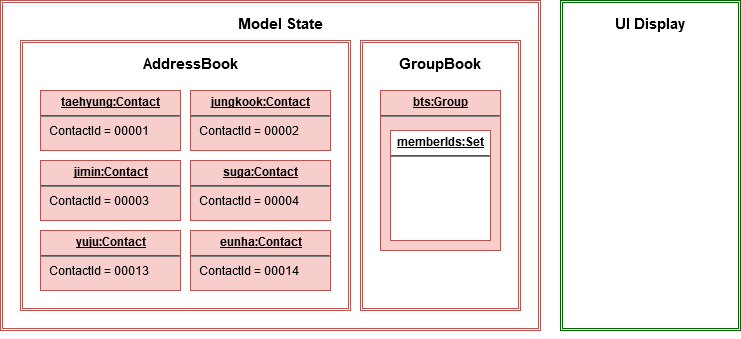
The GroupBook model state now contains a Group instance for "BTS" with no members
recorded as memberIds.
Any command regarding Group would prompt the UI to display the contacts in the group.
A group with no members would cause the UI to be empty. As there are no contacts in the group.
While a group with members in it would cause UI to display all the contacts belonging
to that group.
Step 3. The user then executes group add BTS --i 00001 --i 00002 --i 0013 --i 0004
calling the addMembersToGroupCommand to add several contacts to the group. Only the String
representation of the ContactId will be stored in the Group.

Group "BTS" now has members in it and the UI would display all the contacts found in the
group.
Step 4. The user realizes she has made a mistake adding a wrong contact and in a fit of rage
chooses to delete the contact instead of merely removing the contact from the Group.
Executing contact delete 00013
which then deletes the Contact with contactId of 00013.
However, this does not remove the contact’s id from
the memberId attribute in the Group the contact was in. This step does not involve GroupModel in any way.

Deleting a Contact would cause it to be removed from AddressBook model state and the Contact
no longer exists. Due to the contact command, the active UI shifts to displaying a list
of contacts (not illustrated here for simplicity) and the groups as shown in the image
are actually not visible to the user. However behind the scenes, while
the UI no longer has contact of 00013, it is still recorded as a member
in GroupBook model state. The updating of GroupBook model state is deferred.
Step 5. The user then executes group add BTS --i 00003 to add the correct contact as a member on the Group
and view the Contact profiles.
This calls AddMemberToGroupCommand which then updates the Group ensuring that all memberIds correspond to an existing
ContactId found in AddressBook. The contacts of the group are also displayed to the user.
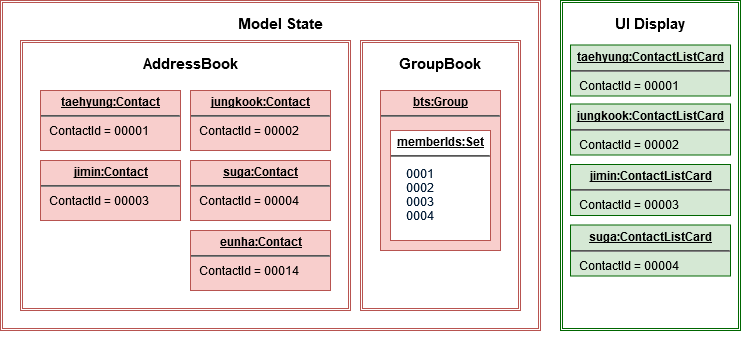
Here, the GroupBook model state is updated and memberId of 00013 from the previous step is removed while Contact
with contactId of 00003 is added into the Group. This change is also reflected in the UI
which changes back to group display now that a group command is issued.
Now all is as it should be in Group "BTS".
The following sequence diagram summarizes what happens when a user executes a FindGroupCommand which
which updates the Group similar to how AddMemberToGroupCommand does in the above example:
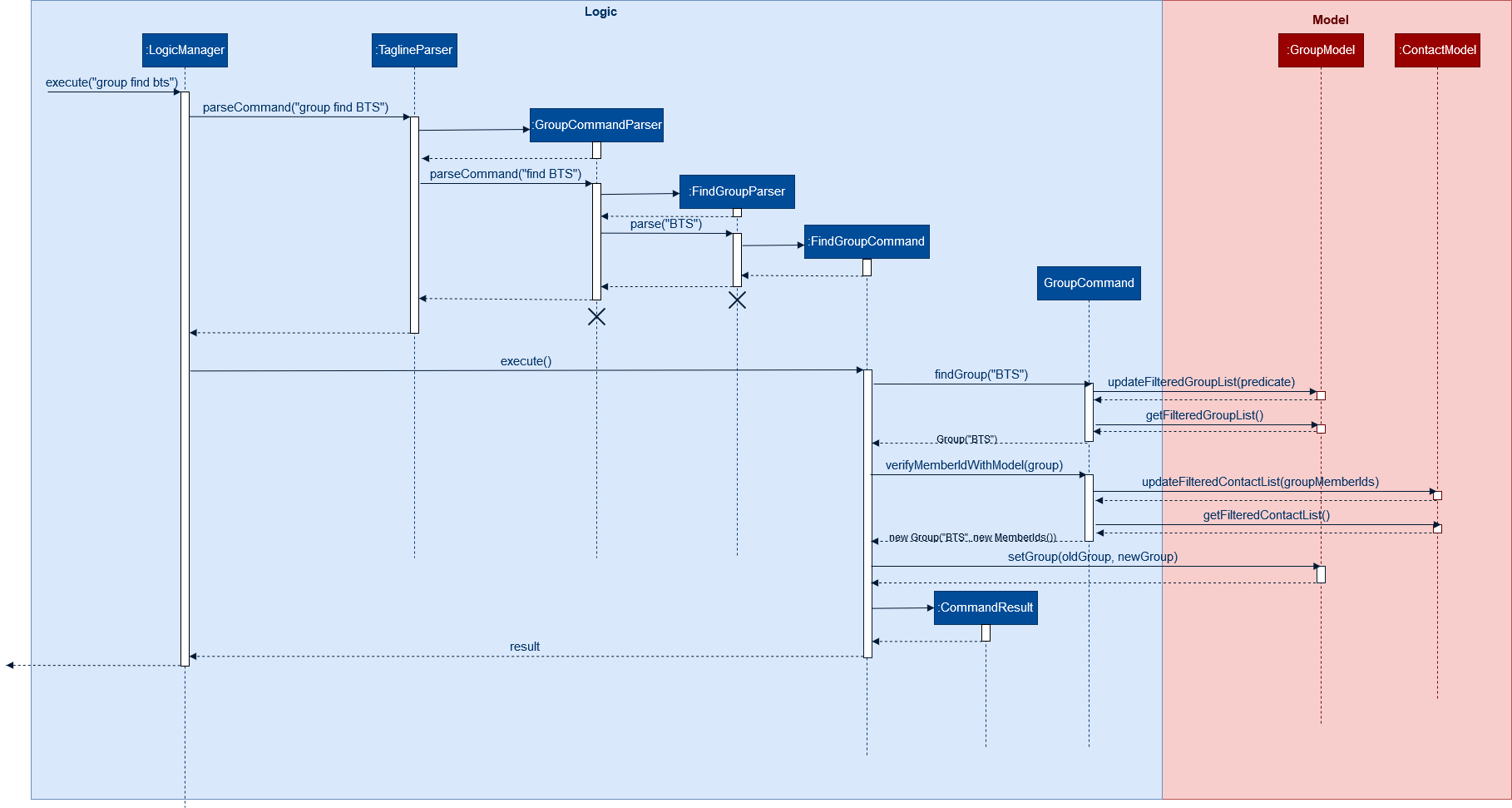
FindGroupCommand to view contacts in a GroupDesign Considerations
Aspect: How groups stores contacts
-
Alternative 1: Stores
ContactIdclass in aCollectioninGroup-
Pros: Easy to get
ContactIdfromGroupto retrieveContactclasses fromAddressbook. -
Cons: Increases coupling to implementation of
Contact. Storage and retrieval after reloading the app would also cause new instances ofContactIdto be created when loadingGroupor would require more complicated loading ofGroupfrom storage having to happen afterAddressBookis loaded and having to referenceContactclasses to ensure the sameContactIdclass is referenced by bothContactandGroupit is in.
-
-
Alternative 2 (current choice): Stores
Collectionof Strings which are able to uniquely identifyContact.-
Pros: Group classes are less coupled to implementation of
Contact. Simpler to loadGroupclasses from storage. due to not needing to check and obtain a reference toContactId. User input is also parsed as Strings. -
Cons: Deciding when to check if members are still part of a
Groupsince it need not be done at loading time. While it is more flexible, can be a potential source of confusion as it may be possible to forget to update the members inGroup.
-